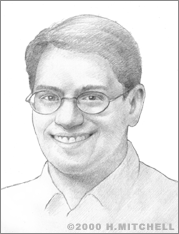Jalal Khan
A team of Massachusetts Institute of Technology (MIT) graduate students conquered a major challenge of high-capacity optical communications by inventing a device that can splice a single signal into or out of the many that are being transmitted together along a fiberoptic line.
The members of the team were all experienced scholars of Electrical Engineering, set to graduate with their PhDs from MIT in 2000. Michael Lim, age 28, born in Seoul, South Korea and raised in Duluth, Georgia, earned an SB from MIT in 1993 and an MS from the University of Southern California in 1995. M. Jalal Khan, age 27, from Karachi, Pakistan, earned both an SB in 1994 and an SM in 1996 from MIT. Thomas Murphy, age 27, born in Arlington, Virginia and raised in nearby Falls Church, graduated with a double major in electrical engineering (BS) and Physics (BA) from Rice University in 1994.
The state of the art in optical communications at the time employed wavelength division multiplexing (WDM), which is the simulaneous transmission of many independent data channels, each at a different carrier frequency, along a single fiber. The different signals could be separated out at the receiving point. However, to achieve maximum efficiency in a network that has multiple nodes rather than a single transmission and receiving point, a method of splitting out (or splicing in) a specific signal or signals at a node, without disrupting the original bundle of signals, was required. Lim, Khan, and Murphy invented a wholly new and improved version of such an integrated “add/drop filter.”
Previously, integrated optical devices operated on lithographic principles used in semiconductors, but such devices are insufficiently subtle to deal with fiberoptic signals. Instead, the team built a filter that uses Bragg gratings to isolate WDM signals. Taking an unprecedented step in nanotechnology, the team built a series of precisely positioned grooves into a ridge waveguide. The grooves act as narrow-band optical resonators, each excited by only one WDM signal. Once isolated, the signal’s optical parameters could be matched with electrical parameters (and vice versa) using computer simulations.
Lim, Khan, and Murphy produced a device whose mechanism was complex, but its impact is easy to understand. By radically increasing the capacity and efficiency of WDM communications, their add/drop filter would improve every person’s access to information, be it by cable television, telephone, or Internet. In addition, the filter’s fabrication process had set the precedent for the large-scale manufacturing of other complex integrated optical devices.
Michael Lim, M. Jalal Khan, and Thomas Murphy succeeded where numerous industrial teams with greater numbers, experience, and funding had failed to find a solution. In honor of their achievement, the team was awarded the first-ever Lemelson-MIT Team Prize for innovation in telecommunications and networking, sponsored by Unisphere Solutions, Inc.


